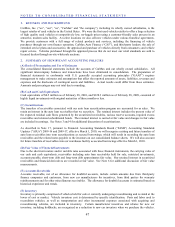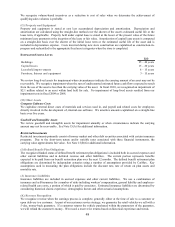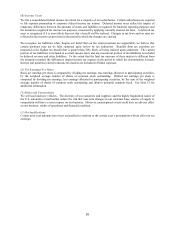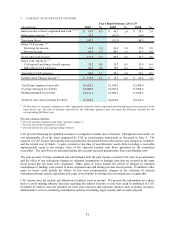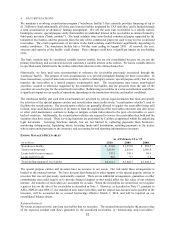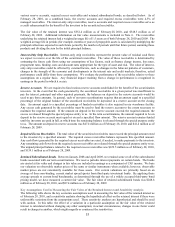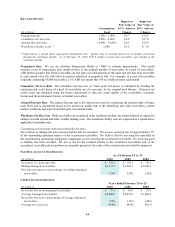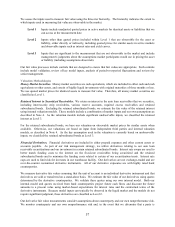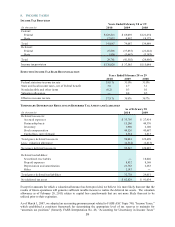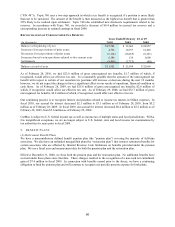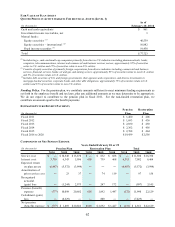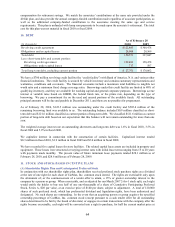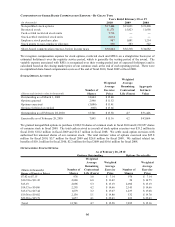CarMax 2010 Annual Report Download - page 67
Download and view the complete annual report
Please find page 67 of the 2010 CarMax annual report below. You can navigate through the pages in the report by either clicking on the pages listed below, or by using the keyword search tool below to find specific information within the annual report.57
We assess the inputs used to measure fair value using the three-tier hierarchy. The hierarchy indicates the extent to
which inputs used in measuring fair value are observable in the market.
Level 1 Inputs include unadjusted quoted prices in active markets for identical assets or liabilities that we
can access at the measurement date.
Level 2 Inputs other than quoted prices included within Level 1 that are observable for the asset or
liability, either directly or indirectly, including quoted prices for similar assets in active markets
and observable inputs such as interest rates and yield curves.
Level 3 Inputs that are significant to the measurement that are not observable in the market and include
management's judgments about the assumptions market participants would use in pricing the asset
or liability (including assumptions about risk).
Our fair value processes include controls that are designed to ensure that fair values are appropriate. Such controls
include model validation, review of key model inputs, analysis of period-over-period fluctuations and reviews by
senior management.
Valuation Methodologies
Money Market Securities. Money market securities are cash equivalents, which are included in either cash and cash
equivalents or other assets, and consist of highly liquid investments with original maturities of three months or less.
We use quoted market prices for identical assets to measure fair value. Therefore, all money market securities are
classified as Level 1.
Retained Interest in Securitized Receivables. We retain an interest in the auto loan receivables that we securitize,
including interest-only strip receivables, various reserve accounts, required excess receivables and retained
subordinated bonds. Excluding the retained subordinated bonds, we estimate the fair value of the retained interest
using internal valuation models. These models include a combination of market inputs and our own assumptions as
described in Note 4. As the valuation models include significant unobservable inputs, we classified the retained
interest as Level 3.
For the retained subordinated bonds, we base our valuation on observable market prices for similar assets when
available. Otherwise, our valuations are based on input from independent third parties and internal valuation
models, as described in Note 4. As the key assumption used in the valuation is currently based on unobservable
inputs, we classified the retained subordinated bonds as Level 3.
Financial Derivatives. Financial derivatives are included in either prepaid expenses and other current assets or
accounts payable. As part of our risk management strategy, we utilize derivatives relating to our auto loan
receivable securitizations and our investment in certain retained subordinated bonds. Interest rate swaps are used to
better match funding costs to the interest on the fixed-rate receivables being securitized and the retained
subordinated bonds and to minimize the funding costs related to certain of our securitization trusts. Interest rate
caps are used to limit risk for investors in our warehouse facility. Our derivatives are not exchange-traded and are
over-the-counter customized derivative instruments. All of our derivative exposures are with highly rated bank
counterparties.
We measure derivative fair values assuming that the unit of account is an individual derivative instrument and that
derivatives are sold or transferred on a stand-alone basis. We estimate the fair value of our derivatives using quotes
determined by the derivative counterparties. We validate these quotes using our own internal model. Both our
internal model and quotes received from bank counterparties project future cash flows and discount the future
amounts to a present value using market-based expectations for interest rates and the contractual terms of the
derivative instruments. Because model inputs can typically be observed in the liquid market and the models do not
require significant judgment, these derivatives are classified as Level 2.
Our derivative fair value measurements consider assumptions about counterparty and our own nonperformance risk.
We monitor counterparty and our own nonperformance risk and, in the event that we determine that a party is


